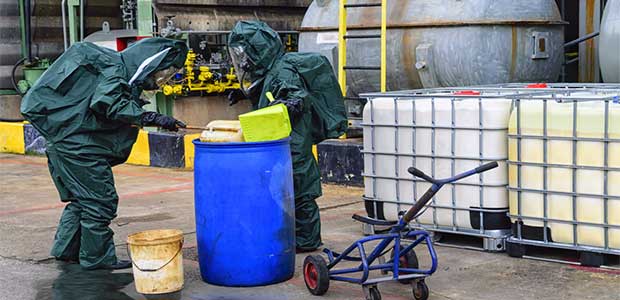
Discussing Basic Spill Response Techniques During HazCom Training
Incorporating incidental spill response techniques into hazard communication training helps to keep employees safe during response.
- By Karen D. Hamel
- Oct 01, 2019
Sometime shortly after the lid is removed from a preschooler’s sippy cup and is carried to the table, the glass slips and the milk is spilled on the floor. Reactions to this event can vary, but most preschoolers will freeze, gasp, and have a look of fear in their eyes. They certainly didn’t intend for this to happen, and they really do not know what to do next.
Spills happen in workplaces, too—but they are usually chemicals, not milk. When employees haven’t been taught how to clean up small spills properly or where to get the cleanup tools and materials, their response might resemble that of the unfortunate preschooler. With the right tools and training, they can quickly become more like a teenager who has been given the chore of cleaning up the bathroom. It certainly isn’t something that they’ve been waiting around all day to do, but they know how to do it, where to get the supplies, and what to do if they need some additional help or resources.
Recognizing Hazards
In workplaces, hazard communication training is a tool for educating employees about chemical hazards. It is used to teach them about the specific safety and health hazards that chemicals present in their work areas and explain how product labels, standard operating procedures, and other safeguards work together to help them avoid these hazards and protect them from harm.
Incorporating incidental spill response as a good housekeeping procedure, and teaching it during hazard communication training, will help promote overall safety efforts in the workplace. It can also specifically minimize the chance of slip and fall incidents and downtime spent looking for someone else to respond to the situation.
Sizing Up Spills
Hundreds of thousands of different hazardous chemicals are used in the industry every day, and each has different properties that can cause harm. Some are flammable, others corrosive, others reactive and/or toxic. Employees must be taught to recognize how these properties can affect them as well as how to respond when hazardous chemicals spill.
Spills can be classified as either incidental or an emergency. A chemical’s properties, the location of the spill, the volume spilled, and the employee’s level of training are all factors to be considered when deciding whether a spill is incidental or an emergency.
Incidental spills are those that do not require employees or others to evacuate the area during cleanup. They do not pose an immediate health risk. They are typically small and can be cleaned up quickly without harm to the employee.
Emergency spills are those that create an immediate health or fire risk to employees in the area. Any employee who will respond to emergency spills must be properly trained in accordance with OSHA’s Hazardous Waste Operations and Emergency Response (HAZWOPER) Regulations. Employees not trained to this level should be taught when to evacuate and who to notify of the emergency spill situation.
Stocking Supplies
Spills are an interruption to the day. Few people are just sitting around waiting for a spill to happen so that they can go clean it up. Stocking spill response supplies in areas where liquids are likely to spill helps employees to clean up spills quickly so that they can get back to their regular duties.
Supplies can include mops and buckets, squeegees, Discussing Basic Spill Response Techniques During HazCom Training Incorporating incidental spill response techniques into hazard communication training helps to keep employees safe during response. BY KAREN D. HAMEL absorbents, paper towels or whatever else is appropriate for the area and the types of liquids that spill in it. Keeping these items in a kit or in a designated area that is well-marked will help employees to remember where the items are located whenever they’re needed.
When absorbent materials are used to clean up small spills, consider where the employee will put the spent materials after they’ve cleaned up the spill. Include bags, buckets, or containers with the spill response materials so that whatever has been used to clean up the spill can be easily removed from the area.
Responding Safely
Although the dangers of hazardous chemicals should never be minimized, properly trained employees who have been taught about the specific hazards of chemicals that they work with every day should be comfortable cleaning up incidental spills. They should also be able to do it without having to don excessive personal protective equipment (PPE), sound alarms, or evacuate everyone in the facility. (These could all be indicators that the spill is an emergency and should be left to HAZWOPER trained responders.)
For incidental spills, response techniques include the following: evaluating whether the spill is incidental or an emergency, donning basic PPE if they are not already wearing it, containing and cleaning up the spill, decontaminating the area and removing spent spill response materials, and reporting the spill so that spent materials can be restocked.
Human nature can certainly play a role in employees’ comfort levels. Some may be willing to tackle spills larger than they should handle, while others may be reluctant to clean up anything more than a few ounces. Providing specific guidance based on the risk assessments performed on the chemicals present in each work area can help keep everyone safe when responding.
Incorporating incidental spill response techniques into HazCom training and standard operating procedures helps to keep employees safe during response. It also helps them to confidently address incidental spill situations with the tools and knowledge to get the job done quickly.
This article originally appeared in the October 2019 issue of Occupational Health & Safety.